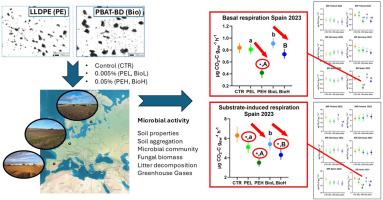传统和可生物降解的农业微塑料:对欧洲土壤性质和微生物功能的影响
IF 7.3
2区 环境科学与生态学
Q1 ENVIRONMENTAL SCIENCES
引用次数: 0
摘要
农用塑料如地膜在降解和破碎过程中可能成为微塑料(MP)土壤污染的主要来源。本研究研究了常规地膜(线性低密度聚乙烯,PE)和可生物降解地膜(淀粉混合聚己二酸丁二酯,pbatb - bd)对土壤理化性质、聚集、微生物多样性和功能、凋落物分解和温室气体排放(GHG)的影响。为此,在代表不同气候条件的三个欧盟国家(芬兰、德国和西班牙)的实验地块上,于2022年以0.005%和0.05% (w/w)的实际MP浓度将MPs混合到土壤中,然后在2022年和2023年随后的生长季节监测上述变量。我们发现了mp对土壤性质、聚集性、微生物多样性、凋落物分解和温室气体的几个显著影响,但影响端点不太明显或差异很大。相反,微生物活动,促进土壤功能,如氮循环,一致地降低了传统和可生物降解的MPs。在第二季和高MP处理后,减少更为明显。由于欧洲较高的多聚磷浓度(即0.05% w/w)与环境相关,我们的研究结果强调了与环境相关的多聚磷浓度对土壤健康的潜在影响。此外,影响从北向南增加,可能受到不同气候条件的调节,这反映出需要根据区域量身定制风险评估,以保护土壤免受塑料污染。本文章由计算机程序翻译,如有差异,请以英文原文为准。

Conventional and biodegradable agricultural microplastics: effects on soil properties and microbial functions across a European pedoclimatic gradient
Agricultural plastics like mulching films may become a major source of microplastic (MP) soil contamination during their degradation and fragmentation. This study investigates the effects of agricultural MPs from conventional (linear low-density polyethylene, PE) and biodegradable (starch-blended polybutylene adipate co-terephthalate, PBAT-BD) mulching films on soil physicochemical properties, aggregation, microbial diversity and functions, litter decomposition, and greenhouse gases emissions (GHG). For this purpose, MPs were mixed into soils at realistic MP concentrations of 0.005% and 0.05% (w/w) in 2022 on experimental plots in three EU countries representing different pedoclimatic conditions (Finland, Germany and Spain), followed by monitoring of the above-mentioned variables in the subsequent growing seasons 2022 and 2023. We found several significant MP-induced effects for soil properties, aggregation, microbial diversity, litter decomposition, and GHG, but the effect endpoints were less pronounced or varied considerably. Contrarily, microbial activity, contributing to soil functions such as nitrogen cycling, was consistently reduced by both conventional and biodegradable MPs. The reductions were more pronounced after the second season and for the higher MP treatment. As the higher MP concentration (i.e., 0.05% w/w) is environmentally relevant in Europe, our findings emphasize the potential effects of environmentally relevant MP concentrations on soil health. Furthermore, the effects increased from north to south, probably modulated by varying pedoclimatic conditions, inducing reflection of a need for regionally tailored risk assessment to protect soil from plastic pollution.
求助全文
通过发布文献求助,成功后即可免费获取论文全文。
去求助
来源期刊

Environmental Pollution
环境科学-环境科学
CiteScore
16.00
自引率
6.70%
发文量
2082
审稿时长
2.9 months
期刊介绍:
Environmental Pollution is an international peer-reviewed journal that publishes high-quality research papers and review articles covering all aspects of environmental pollution and its impacts on ecosystems and human health.
Subject areas include, but are not limited to:
• Sources and occurrences of pollutants that are clearly defined and measured in environmental compartments, food and food-related items, and human bodies;
• Interlinks between contaminant exposure and biological, ecological, and human health effects, including those of climate change;
• Contaminants of emerging concerns (including but not limited to antibiotic resistant microorganisms or genes, microplastics/nanoplastics, electronic wastes, light, and noise) and/or their biological, ecological, or human health effects;
• Laboratory and field studies on the remediation/mitigation of environmental pollution via new techniques and with clear links to biological, ecological, or human health effects;
• Modeling of pollution processes, patterns, or trends that is of clear environmental and/or human health interest;
• New techniques that measure and examine environmental occurrences, transport, behavior, and effects of pollutants within the environment or the laboratory, provided that they can be clearly used to address problems within regional or global environmental compartments.
 求助内容:
求助内容: 应助结果提醒方式:
应助结果提醒方式:


